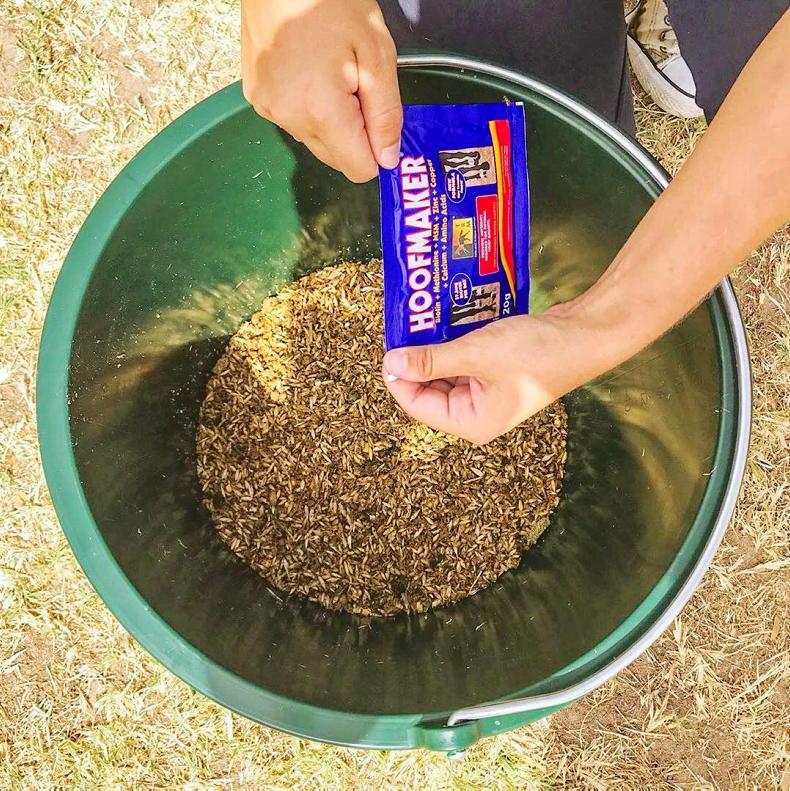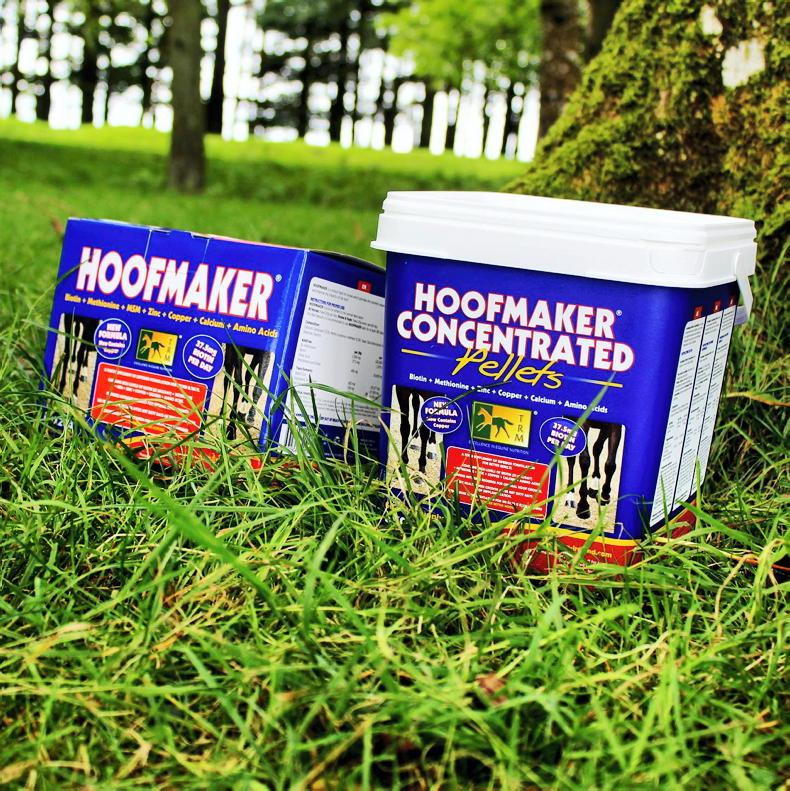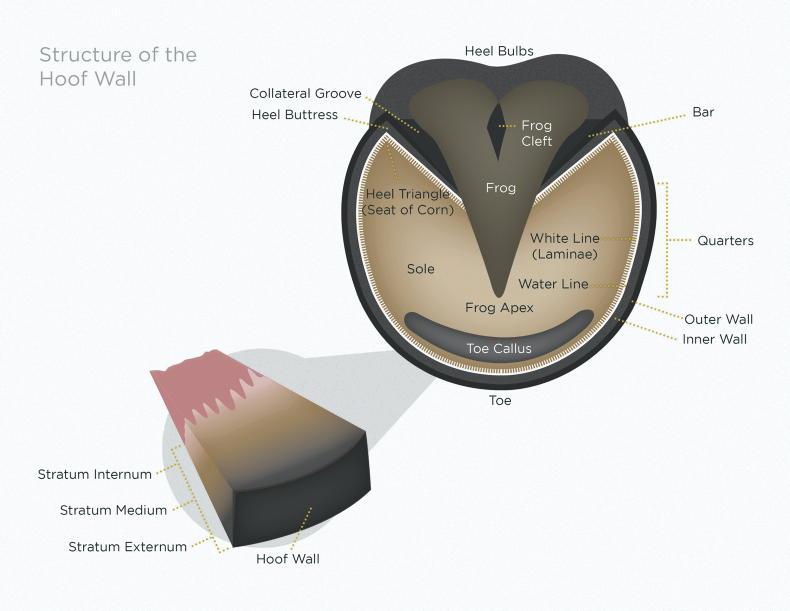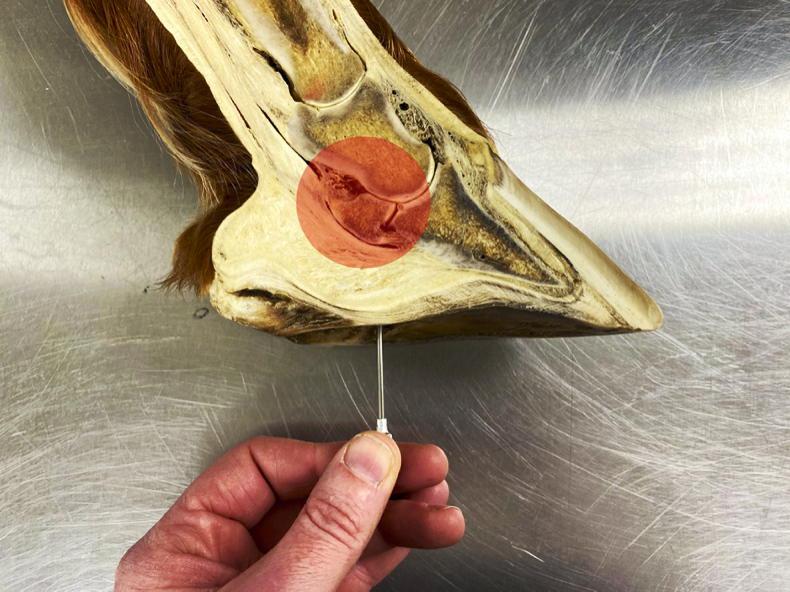WITH customers including champion trainer Willie Mullins, Irish show jumper Denis Lynch and Olympic gold medallist Steve Guerdat, TRM’s dedication to equine care and nutrition is long established.
When it comes to hoofcare TRM advocate for a holistic threefold approach to be implemented. TRM have also developed a bespoke hoofcare supplement called Hoofmaker. Hoofmaker provides all of the nutrients necessary to protect and nourish every layer within the hoof horn. This ‘sulphur enriched’ formula will ensure that important nutrients are supplied to the horse, to ensure optimum hoof growth and improved integrity of the hoof.
Hoofcare: a three-fold approach to health
1 Nutrition: The hoof horn is primarily made from horn cells and keratin sulphate. If the horn is somehow deprived of good quality protein, bioavailable sulphur, calcium, zinc or biotin, irregularities can occur. This will manifest itself as cracks. All horses in training should receive a balanced diet, if they are expected to perform at the very highest level. Nourishment of the hoof and the underlying structures should receive primary attention, as they are the foundation of the horse. Lameness is the biggest reason for under performance in the horse. Interestingly, foot lameness is the most common type of lameness seen in the equine athlete.
2 Foot hygiene: First and foremost, stables should be designed to incorporate a ‘run-off’ for urine and water. Fresh air should be a priority in the stable environment. The choice of bedding is subjective, however it is important that whatever bedding used, it should not be too dry as this will compromise the natural moisture content of the hoof horn. The bedding should be kept as fresh as possible. This will reduce the build-up and establishment of endemic bacteria and fungi within the stable environment. Several of these micro-organisms have a natural tropism for hoof tissue e.g., Thrush.
3 Farriery: A qualified farrier should always conduct trimming and shoeing work. The farrier has a huge influence on the balance of the foot. Preparation of the hoof, the type of shoe used and its placement, will all affect the displacement of force on the forefoot and adjoining limb. Many hoof defects are multi-factorial in their origin. Incorrect shoeing and neglect can be one of the pre-disposing factors to disease and the breakdown of hoof horn function, cracks and brittle hooves. Proper hoof care, hygienic housing conditions and the feeding of Hoofmaker combined, are the best approach for ensuring hoof health and optimum hoof growth.
TOPOGRAPHICALLY the hoof is divided into three regions: the toe, the medial and lateral quarters, and the heels. The heels of the wall are reflected inward and form the bars, which are separated from the frog by the paracuneal grooves. The wall is thickest at the toe and gradually thins towards the heel.
When there is a crack or malformation in the hoof wall, the weakness can normally be located, either in the outer layer of the wall (stratum externum) or the middle and inner layers (stratum medium and stratum internum).
An accurate diagnosis can only be made by electron microscopy and biopsy. While it is impossible to ascertain by the human eye where the weakness originates from, the correct diagnosis is very important in terms of the nutritional therapy that should be applied, to help resolve the problem.
THE wall is designed to carry the bulk of the horse’s weight as well as protect the underlying structures. The bars act as a brace to control over expansion and contraction of the hoof. The sole covers the softer tissues and is somewhat concave to give grip and allow for expansion. The frog aids in absorbing concussion, circulation and regulating moisture in the hoof. The three layers arise from the epithelium covering the coronary dermas. The outer layer is an extremely thin layer of tubular horn covering the entire surface of the wall.
The middle layer, or stratum medium, consists of a very thick hard layer of tubular and inter-tubular horn. The proximal portion divides to form the coronary groove, in which lies the convex coronary corium. It is pigmented when the hoof is dark. The middle portion actually comprises the bulk of the hoof wall.
The spaces between the horn tubules are filled with inter-tubular horns. The internal layer or stratum internum is always non-pigmented and consists of many keratinised primary epidermal lamellae which extend from the coronary groove to the ground surface.
Hoof cracks
Scientific research has found that hoof cracks originate in one or two of these three layers. Research has also shown that the origin of the hoof defect should ultimately decide the choice of nutritional therapy. Cracks that originate in the stratum externum respond very well to biotin supplementation. Cracks that originate in the stratum medium and stratum internum will respond better to the addition of protein, calcium, bioavailable-available sulphur, zinc and copper to the biotin supplement.
Hoofmaker is the ultimate hoof supplement as it contains a high concentration of biotin, bioavailable sulphur, methionine, calcium, zinc and copper together with a full array of amino acids to correct any nutritional deficiencies that may have triggered hoof wall defects.


 This is a subscriber-only article
This is a subscriber-only article
 It looks like you're browsing in private mode
It looks like you're browsing in private mode











SHARING OPTIONS: